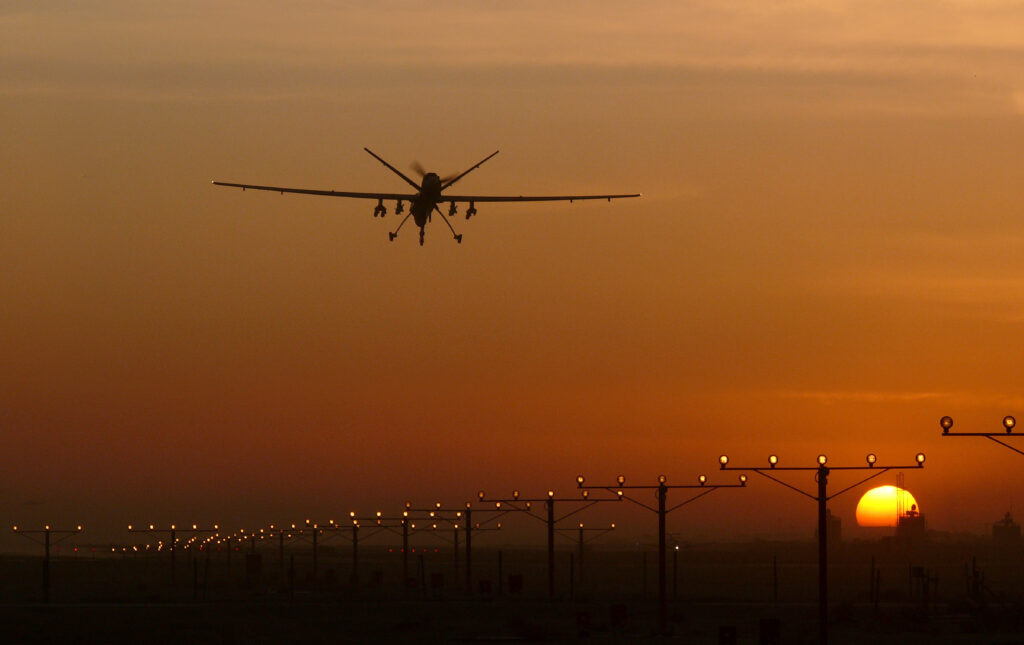[A shorter version of this piece was published in the German-language ct Magazin für Computertechnik in September 2021, Ingvild Bode & Tom Watts]
The United States and its NATO partners have ignominiously withdrawn from Afghanistan. One of this war’s many legacies will be the use of remotely piloted aircraft – colloquially referred to as drones – to conduct air strikes against suspected militants. Afghanistan holds a distinct place in the history of drone warfare: it is the site of the United States’ first attempted drone strike, a failed October 2001 operation conducted by a CIA Predator drone intended to kill the Taliban leader Mohammed Omar. Twenty years later, drones have become an ubiquitous feature of American warfighting. The war in Afghanistan has been a major driver of this trend and suggests that, whatever the technical capabilities of these systems, they are far from a “silver bullet” for fighting a well-motivated and determined insurgency like the Taliban.
Drones have been described as the “signature aircraft of the war in Afghanistan”. Prior to the 9/11 attacks, the United States operated a comparatively small fleet of unarmed drones which were primarily used to conduct reconnaissance operations. A major driver for weaponizing these systems was the attempt to kill Osama Bin Laden and other “high-value” terrorist targets. Drones like the MQ-1 Predator combined what had previously been two separate military capabilities – persistent surveillance and precision airstrikes – reducing the time between when a target was identified, and when it could be attacked from the air. Purpose built military-grade drones come in all shapes and sizes. These range from the sixteen-gram nano-drones like the Black Hornet used by NATO soldiers to provide “over-the-hill” tactical reconnaissance through to the nearly 7,000 kilogram Global Hawk used to survey entire battlefields. A common feature of all drone technologies is that they can be piloted from a physical distance and, unlike other “unmanned” technologies like cruise missiles, can be recovered and reused (Boyle 2020, 8). Research conducted by the Center for the Study of the Drone suggests that nearly thirty different types of military-grade drones have been produced within the United States. The MQ-9 Reaper and the MQ-1C Gray Eagle drones both played a prominent role in the Afghanistan war, conducting roles considered “dull, dirty or dangerous” (DOD 2007, 19).
First deployed by the US Air Force to Afghanistan in October 2007, the MQ-9 Reaper is equipped with a Multi-Spectral Targeting System which contains a range of sophisticated cameras and sensors. This allows its two immediate operators – a pilot and a sensor operator – to survey the battlefield from both an infrared and full-motion video perspective. The Reaper, which also carries electronic warfare pods which collect mobile phone data, can be armed with a variety of munitions including up to eight Hellfire missiles and two larger GBU-12 Paveway II laser-guided bombs. The MQ-9 Reaper has a listed operational range of 1,150 miles and can stay airborne for over twenty-four hours. At one point in 2018, Kandahar Airfield in Southern Afghanistan was home to three squadrons of MQ-9 Reapers. Although the exact number of Reapers in operation was not reported, this made it the “largest deployment of the type to a single base ever”.
Operated by the American Army, the MQ-1C Gray Eagle can be armed with four Hellfire missiles, is equipped with a sophisticated sensory suite and can remain airborne for over twenty-four hours. Gray Eagle drones were first deployed to Afghanistan in late 2010. Like the Reaper, they were used to conduct a variety of missions. These included offering near-continuous battlefield intelligence to NATO commanders, detecting evidence of improvised explosive devices, and providing close air support to partnered forces. As one former military officer put it: “If you’re looking to whack somebody who needs whacking, then send the Gray Eagle” (Quoted in Boyle 2020, 109).
Germany’s role in the American drone programme
To operate drones like the MQ-1C Grey Eagle and MQ-9 Reaper in the Middle East and Africa, the United States relies on a complex network of military bases, satellites, and fiber-optic cables. Ramstein Air Base is a crucial node in this network. As reported by Der Spiegel and The Intercept in 2015, “[w]ithout Ramstein, drones could not function, at least not as they do now”. Ramstein serves as the satellite communications station from which drone operators based at Creech Air Force Base in Nevada connect to the aircraft which they remotely pilot in faraway battlefields.
Drone strikes are not directly controlled from Ramstein. Nonetheless, the base plays a crucial role in processing and analysing sensor data collected by drones via the Distributed Common Ground System (DCGS). The analysis of this data, communicated to American drone operators via the encrypted mIRC chat programme, directly informs how and why drone attacks are conducted in Afghanistan – and elsewhere. The DGCS works with data that is stored in both its own database and the databases of other national security agencies. This data is stored across different “silos” depending on which sensor collected it. Once collected, sensor data remains active in the system and becomes the basis for targeting decisions.
Currently, the system of analysing such sensor data is a labour-intensive process which involves multiple human operators. Because of this, we may see an increasing reliance upon AI as a means of processing and analysing sensor (and other forms of) data for drone strikes via the DCGS. The US aims to store all data in one big repository that can be retrieved by US military personnel anywhere in the world. AI is planned to play a central role in comparing the vast amounts of data which is collected by American military aircraft as a means of identifying patterns that humans are unable to spot. This process would include automation in order to manage the disparate pieces of data that are in the system and make it “actionable” for American military commanders. The fact that the US Air Force has become the lead agency for Project Maven and its successor programmes evidences this trajectory, and speaks to the further integration of AI across the different stages of the targeting cycle from target analysis to target assessment. This development may have serious repercussions for the ability of humans to remain in meaningful control of the targeting cycle as there are significant functional limits to the extent to which human operators can doubt or question targeting analysis provided by AI systems.
Pixels and metadata
Depictions of drones in some forms of popular culture often make it seem as if drone operators make their targeting decisions based on an analysis of HD full-motion-videos. But, the reality of drone operations is quite different: ”drone feed imagery … is sometimes so unclear that pilots cannot distinguish between objects and people”. This observation cannot make us confident of the drone operators’ ability to distinguish between combatants and civilians. In fact, as the former director of both the National Security Agency and the CIA Michael Hayden asserted: ”We kill people based on metadata”.
The type of information which the targeting decisions for drone strikes are based on is important for assessing whether they adhere to international law. In contrast to Pakistan, Yemen, and Somalia, the US conducted drone strikes in Afghanistan as a party to an armed conflict, thereby allowing for the killing of combatants according to the laws of war. As such, drone strikes in Afghanistan were not subject to the same fundamental disputes as the targeted killings conducted by the US on the territories of countries where it is not a party to an ongoing armed conflict.
But even in situations of armed conflict, all parties have clear, general obligations under international law to protect civilians. Such obligations require parties to distinguish between civilians and combatants at all times, no matter which weapon platform they deploy. Where data is available, there is a significant variation in the reported number of Afghani civilians killed in these airstrikes.
Incomplete numbers
A range of different (and incomplete) statistics have been compiled on the numbers of drone strikes conducted in Afghanistan. The most comprehensive set of statistics have been put together by the Bureau of Investigative Journalism (BIJ) through a combination of open-source material and field investigations. On their estimates, a minimum of 15,094 drone strikes were conducted by US forces in Afghanistan between January 2008 and February 2020.
Figure 1: Number of drone strikes and weapons released by aircraft in Afghanistan, 2008-2020
| NATO air and drone strikes in Afghanistan (source: BIJ) | Weapons released by US-manned and unmanned aircraft (source: US Air Force) |
2008 | 130 | No data available |
2009 | 196 | 1733 |
2010 | 206 | 1816 |
2011 | 238 | 1675 |
2012 | 245 | 1975 |
2013 | No data available | 1407 |
2014 | No data available | 2365 |
2015 | 235 | 947 |
2016 | 1071 | 1,337 |
2017 | 2609 | 4,361 |
2018 | 1985 | 7,362 |
2019 | 7167 | 7,423 |
2020 | 1012 | 415 |
The US Department of Defence released data on the number of weapons released by manned aircraft and drones through to early-2020 (see figure 1). At that point, the Trump administration signed a peace agreement with the Taliban and announced that it would no longer publish monthly reports on the number of airstrikes conducted in Afghanistan. The significant increase in the number of air and drone strikes conducted after 2016 illustrated in Figure 1 can be attributed to the Trump administration loosening the rules of engagement, therefore giving a freer rein for military commanders to conduct military operations in Afghanistan. This led to a significantly higher civilian death toll, as figure 2 shows.
Figure 2. Numbers of Afghani civilians killed and injured by US and international air strikes, 2007-2020
| Number of Afghani civilians killed and injured by international airstrikes (source: UNAMA) | Number of Afghani civilians killed by US military operations (source: Department of Defense)
| |
2007 | Killed and injured: 335 | N/A | |
2008 | Killed and injured: 552 | N/A | |
2009 | Killed and injured: 359 | N/A | |
2010 | Killed and injured: 171 | N/A | |
2011 | Killed and injured: 235 | N/A | |
2012 | killed | injured | N/A |
126 | 78 | ||
2013 | killed | injured | N/A |
118 | 64 | ||
2014 | killed | injured | N/A |
104 | 58 | ||
2015 | killed | injured | N/A |
103 | 67 | ||
2016 | killed | injured | N/A |
127 | 108 | ||
2017 | killed | injured | N/A |
154 | 92 | ||
2018 | killed | injured | 70 |
393 | 239 | ||
2019 | killed | injured | 98 |
546 | 209 | ||
2020 | killed | injured | 20 |
89 | 31 | ||
According to data compiled by the United Nations Assistance Mission in Afghanistan (UNAMA), 3,458 Afghani civilians have been killed by international air forces since 2007. The US Air Force has only released official numbers of civilian casualties from 2018-2020, amounting to 188 civilian lives lost. UNAMA numbers for the same period reported 1,028 civilian casualties. The differences in these figures result from using diverging definitions of who counts as a civilian and who counts as a combatant. NGOs have notably criticized the US understanding of combatants as overly broad. Of course, attacks attributed to the Taliban have also led to significant numbers of civilian casualties. In 2020 alone, such attacks killed 1,470 civilians.
Living under drones
Until the dust fully settles on the Taliban’s return to power it is difficult to reach a firm conclusion regarding the extent to which drone warfare shifted the Afghani population’s perception of the NATO-backed government in Kabul. The Afghan National Army’s collapse was, as P. Michael McKinley has recently argued, a consequence of nearly two decades of political and military miscalculation. For the communities directly impacted by the various forms of civilian harm which drone strikes have produced, they are likely to have been a considerable point of anger and resentment.
A November 2013 drone strike conducted in Helmand province against a Taliban fighter which also killed a child and injured two women became a major source of friction between the two countries. According to then Afghani President Hamid Karzai, this strike demonstrated how “American forces are not respecting the life and safety of Afghan people’s houses” and was a contributing factor for his reluctance to conclude an agreement to allow NATO forces to stay in the country after 2014. Initial media reports estimated that a later September 2019 drone strike against a suspected Islamic State hideout in the eastern province of Nangarhar killed thirty civilians. As the Costs of War Project have documented, the overall number of civilian deaths caused by airstrikes in Afghanistan increased significantly following the Trump administration’s 2017 decision to loosen its rules of engagement for targeting militant groups. Yet, even these figures provide only a partial picture of the civilian harm which these technologies have produced. “Living Under Drones”, as it has been called, can also create acute psychological trauma for local populations who come to live in constant fear of airstrikes from craft they cannot see.
The coming end of the “Forever War” in Afghanistan raises a counterfactual question deserving of further scrutiny: how and when would US forces have left the country if drones had never been weaponised? Two of the most common justifications for drone strikes is that they reduce American military casualties and result in less civilian deaths than attacks from manned aircraft or cruise missiles. If this is indeed the case, it is conceivable that the use of drone technologies helped prolong the US’ involvement in this conflict by reducing its associated political costs, particularly after the end of the formal end of NATO combat operations in December 2014. At the same time, in both Afghanistan and neighbouring Pakistan, drone strikes have killed many high-profile Taliban leaders including Mullah Fazlullah Khorasani, leader of the Pakistani Taliban, and Mullah Abdul Salam, a senior Taliban commander operating in North Afghanistan. Such tactical successes aside, the Taliban’s return to power in Afghanistan highlights their limits as a tool for fighting a well-motivated insurgency able to outwait and politically outmanoeuvre an intervening military power. Drone strikes may not have “lost” Afghanistan, but neither did they provide a technological “silver-bullet” for imposing the United States’ political preferences.











